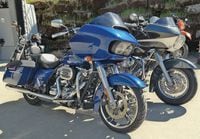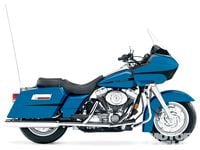WRIST: Andy Cherney MSRP (2015): $23,699 MILES: 10,459 MPG: 41 MODS: None UPDATE: 7
I've spent the better part of eight months and 10,000 miles on the Harley-Davidson Road Glide Special without giving much thought to the origins of—and changes to—a model that's been in H-D's lineup (on and off) for nearly 20 years. So when I spotted this 2006 example at a local shop, I knew it'd be a cool photo op as well as a possible history lesson.
This 2006 Road Glide’s current pilot, Jameson, says his bike has 30,000 miles on it, and he’s the second owner. His bike is basically all stock (except for the pipe, of course), but when we lined up the two machines side by side, we were struck by how much taller the older model was and how much more the 2015 model stretched out. Also notable were the contrasting tire profiles: The 2006 model’s front 16-inch tire is a good deal chubbier than the rear one—the reverse of the 2015 model’s tire setup, which runs with tall, narrow front rubber and a fat rear.
The Road Glide’s design was rooted in the FLT Tour Glide, dropped from the lineup in 1996. A smaller version of that bike’s frame-mounted fairing returned with the FLTR Road Glide in 1998, which, by 1999, sported a Twin Cam 88 engine. (In 2009, Harley-Davidson redesigned the entire touring range, swapping in a new frame, swingarm, a totally revised engine-mounting system, and a new fuel tank, among other changes.) Then, of course, there are the obvious Rushmore improvements on the new model—the new fairing is much narrower and more streamlined, the new saddlebags are more angular, and the signature dual headlights have a dramatically revised shape. Plus a larger engine, an extra ratio in the gearbox, and a world of refinement. Who says Harleys never change?


/cloudfront-us-east-1.images.arcpublishing.com/octane/D2BDYKKNZ5GRHGDMI4PZTGRMME.jpg)

/cloudfront-us-east-1.images.arcpublishing.com/octane/UAY4WSZPOFDQRP4MCEXAKDFQOQ.jpg)

/cloudfront-us-east-1.images.arcpublishing.com/octane/X5CE3KSJHZHM5CUFGPZ7U26WB4.jpg)
/cloudfront-us-east-1.images.arcpublishing.com/octane/COWLTPGFAFGDDGJCTENYMA4VJM.jpg)
/cloudfront-us-east-1.images.arcpublishing.com/octane/H3PKUGPSUJFTND4RFPSI4OIDCE.jpg)
/cloudfront-us-east-1.images.arcpublishing.com/octane/UHGQA3MQDFCA3HLBWF7S76WH6Y.jpg)
/cloudfront-us-east-1.images.arcpublishing.com/octane/Q5EORCSTNFAVBJC4IYUHIKJTXQ.jpg)
/cloudfront-us-east-1.images.arcpublishing.com/octane/XIJ5FUFSP5A3NL7MOVZGJXAHC4.jpg)
/cloudfront-us-east-1.images.arcpublishing.com/octane/V5NZN3CGS5B5PPYFYJHIPAU5S4.jpg)
/cloudfront-us-east-1.images.arcpublishing.com/octane/CZE6ONOBU5E7HPIEEADU376C4M.jpg)
/cloudfront-us-east-1.images.arcpublishing.com/octane/UT4KL3SIYJBSPNHWJXTBE6MTGE.jpg)
/cloudfront-us-east-1.images.arcpublishing.com/octane/Q3UOIDZ22ZEVDBZUWGJXIMGJKI.jpg)
/cloudfront-us-east-1.images.arcpublishing.com/octane/YQM66WXZV5AAXNNOIUVOGVXZMY.jpg)
/cloudfront-us-east-1.images.arcpublishing.com/octane/J47NFTXNLFFGHELHZCUD2LCITA.jpg)
/cloudfront-us-east-1.images.arcpublishing.com/octane/NXPQBTLX3NCILKQ2GCFJYNIDEM.jpg)
/cloudfront-us-east-1.images.arcpublishing.com/octane/6U7NJLAYMRBZTIGNKWIA5OK2FQ.jpg)
/cloudfront-us-east-1.images.arcpublishing.com/octane/IYTZQWUROVC25IMTDEWUDQ5IQE.jpg)
/cloudfront-us-east-1.images.arcpublishing.com/octane/YJODDXEL2ZB5TENKPPN4BEYJAE.jpg)
/cloudfront-us-east-1.images.arcpublishing.com/octane/QEQQUZYNJFAIJB4DZFVFSNTCQ4.jpg)
/cloudfront-us-east-1.images.arcpublishing.com/octane/F4EEHDT3UZFKPLKVGDWMMPFEQE.jpg)
/cloudfront-us-east-1.images.arcpublishing.com/octane/J47U6OWNLBFBBG75A3ILAKFYZU.jpg)
/cloudfront-us-east-1.images.arcpublishing.com/octane/XWWQYTL3J5B7LKXDI354FFF4NQ.jpg)